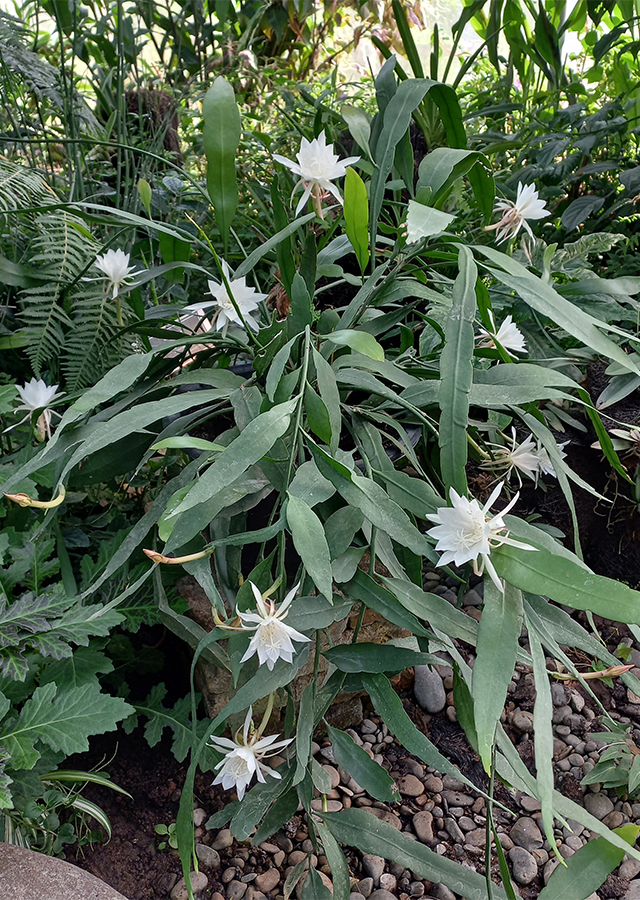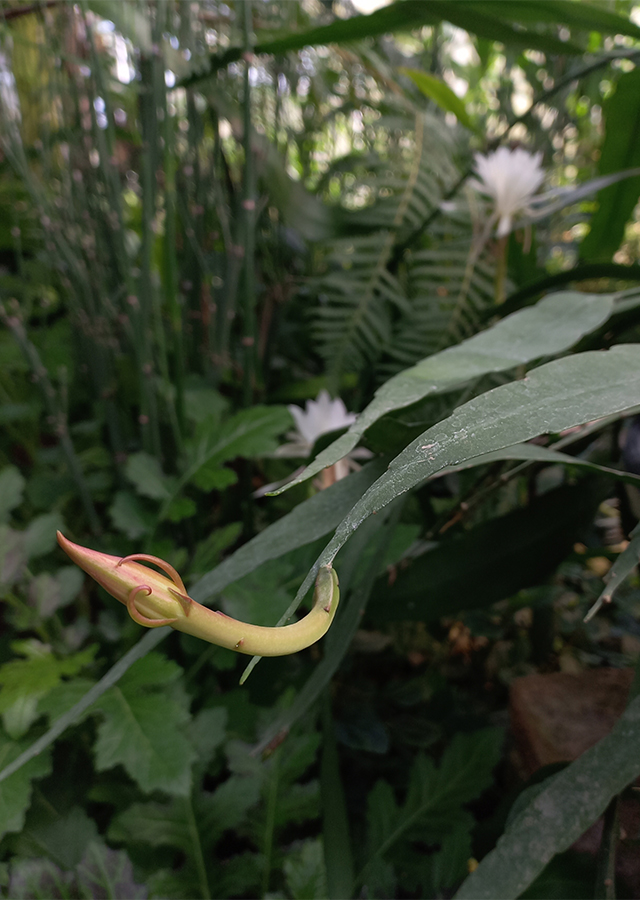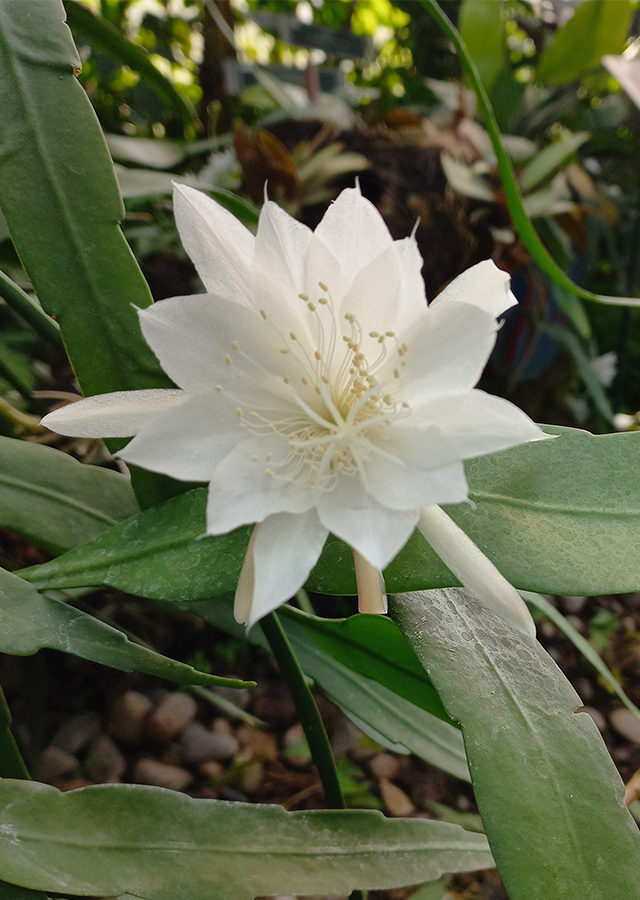Climbing Cactus
Epiphyllum phyllanthus (L.) Haw.
Cactaceae
Location in our garden
Green House



Synonym
Cactus phyllanthus L.
Cereus phyllantus (L.) DC.
Opuntia phyllanthus (L.) Mill.
Habitus
Succulent. Succulent, perennial, epiphytic
Part Used
Flowers
Stem
Growing Requirements
Full Sunshine
Need Shade
Habitat
Forest
Terrestrial
Overview
Epiphyllum phyllanthus is a flowering succulent plant of the Cactaceae family that is widespread in South America, extending from southern Mexico to Paraguay, Northwestern Argentina and southern Brazil. This species is widely grown as an ornamental plant and is a species native to Mexico. In Indonesia, this species is often considered a mystical plant. In Javanese mythology, this flowering plant is considered 'sakti' and is able to bring the dead to life. This species is generally taken from nature for use as food and medicine. Where, the fruit of E. phyllanthus can be consumed raw. The fruit has a delicious flesh and slimy with a slightly sweet taste. In addition, based on its function as medicine, E. phyllanthus has also been used by the community in its traditional medicine and is believed to have good health benefits.
Vernacular Names
No data found on this. Need further research.
Agroecology
Epiphyllum phyllanthus is usually found growing mainly in seasonally dry tropical biomes and in moist or wet forests as epiphytes. Grows near sea level to at least 1,300 m asl. E. phyllanthus can grow in full sun, but thrives in partial shade. Extra light in early spring will stimulate the shoots. E. phyllanthus prefers night time temperatures no cooler than 12 °C, especially in winter, and can tolerate temperatures up to 45 °C, and short periods of frost, but prolonged cold will damage or kill the plant. E. phyllanthus can usually live in a wide variety of soils, but because of its epiphytic nature, it is recommended to be planted in a mixed medium, well-drained soil consisting mostly of organic matter, such as peat or sphagnum moss. E. phyllanthus can also live in soils with a pH of 5.0 to 9. However, this species prefers soils with a higher alkaline pH of 6.2 to 7.0. E. phyllanthus can withstand moderate to high humidity levels. In fact, this species requires moderate to high humidity for its growth.
Morphology
- Stems - primary round elongated, terete transverse or angular/winged 3 below 50-100 cm long or more, often branched, then flattened or thin (leaf-like) 100 cm long. Secondary stems arise from the primary stem which is flat, spherical across to three angles at the base, then flat and linear with a length of about 25-50 cm and a width of 3-10 cm, green with a very clear purple border, stiff to flexible, with prominent midrib, slightly lobed edges and toothed, blunt teeth. The stem has aerial roots.
- Areoles - small, located along the edges of branches that are sometimes hairy, usually just a cream-colored wool.
- Flowers - aromatic, up to 30 cm long, located on the edge of the flat part of the stem. The slender perianth tube is much longer than the branches, straight on the erect stem, and strongly curved on the hanging stem. The outer perianth segment is greenish yellow colored red, while the inner perianth segment is narrow 2.5-10 mm wide, white to cream. The scales on the flower tube are few, spread out. Filaments are short and white while the anthers are light brown. Style is long, slender, pink or white. Stigma-lobes about 10 short, white. Flowers open at night (nocturnal) and have a strong scent that radiates at night. The bloom lasts only for a short time for 1 night.
- Fruits - pink-purple when ripe, has white flesh, slimy and sweet taste.
- Seeds - large, black, and numerous.
Cultivation
- Plant propagation is mostly done through leaf-like stem cuttings or through seeds (rarely) in the spring.
- Seeds should be sown in a well-drained seedling medium and germinate in 14 to 28 days at 18 to 21 °C.
- Through the cuttings, cut the leaf-like stems 15 - 23 cm (6 - 9 in) long and allow the callus (to dry) for a few days in a warm place. Fill the pot one-third full with compost and cover with a layer of sand. Insert cuttings 3-5 cm deep. Keep the compost moist and maintain a temperature of 18 - 24 °C. This plant can take root in three to six weeks and flower the following year.
Chemical Constituents
No data found on this. Need further research.
Traditional Medicinal Uses
- Treats broken bones, rheumatism.
- Accelerates healing of tuberculosis (tuberculosis), whooping cough, coughs and colds, back pain.
- Acts as a laxative.
Part Used
Reference Sources
- Royal Botanic Gardens. Plants of the World Online: Epiphyllum phyllanthus (L.) Haw.. https://powo.science.kew.org/taxon/urn:lsid:ipni.org:names:132939-1. 24-09-22.
- LLIFLE - Encyclopedia of living forms. 2022. Epiphyllum phyllanthus. http://www.llifle.com/Encyclopedia/CACTI/Family/Cactaceae/8523/Epiphyllum_phyllanthus. 24-09-22.
- Almeida O. J. G., Paoli A. A. S., Souza L. A. 2010. Flower morpho-anatomy in Epiphyllum phyllanthus (Cactaceae). Revista Mexicana de Biodiversidad 81: 65- 80.
- Arnason et al. 2022. A review of ethnobotany and ethnopharmacology of traditional medicines used by Q’eqchi’ Maya Healers of Xna’ajeb’ aj Ralch’o’och’, Belize. Botany 100: 219–230.
- PlantingMan. Climbing cactus (Epiphyllum phyllanthus). https://plantingman.com/climbing-cactus-epiphyllum-phyllanthus/. 2309-2022.

